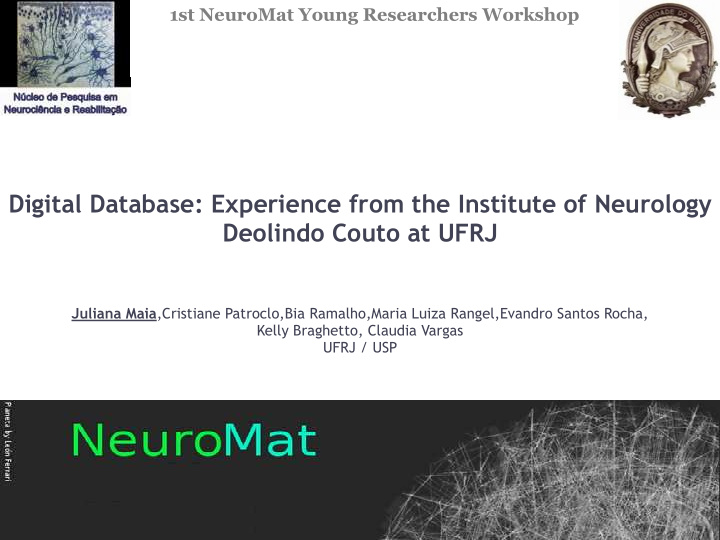



1st NeuroMat Young Researchers Workshop Digital Database: Experience from the Institute of Neurology Deolindo Couto at UFRJ Juliana Maia ,Cristiane Patroclo,Bia Ramalho,Maria Luiza Rangel,Evandro Santos Rocha, Kelly Braghetto, Claudia Vargas UFRJ / USP
2 Introduction � Public Databases are fundamental for the effective advance in the understanding of brain function and treatment of its dysfunctions. � In neuroscience, the provision of public Data is a global trend, and building a database that will allow the recovery of clinical and neurophysiological information in a systematic way is a challenge in contemporary science � This challenge lies in the interface between computer science, neurobiology, statistics and medicine.
3 Objective CePID INDC/UFRJ Create a digital database of public access falls within the context of the The Research, Innovation and Dissemination Center for Neuromathematics (CePID NeuroMat). � In 2014 began the creation of database that stores in a standard and secure manner the data set collected in the Neuroscience and Rehabilitation laboratory (LabNer) in INDC/UFRJ, facilitating its sharing and reuse.
4 Methods and Results Prototype: Database from patients with brachial plexus injury (BPI). � BPI occurs primarily by automobile accidents in young people, affecting motor and sensory nerves for upper limb. The main treatments are intense physical therapy and surgical reinnervation of the brachial plexus. � BPI is an important model to investigate mechanisms of brain plasticity following peripheral injury. Example of brachial plexus injury mechanism. Injury by stretching and compression.
5 A Multidisciplinary Team The database for the BPI study was designed in INDC/UFRJ by: • Doctors � • Physiotherapists � • Neuroscientists USP: � NeuroMat Researchers
6 Steps to create the database: Steps to create the database: Step 1: General Information • Patient Registration • Socio-demographic data • Social History • Medical history and complementary exams (longitudinal)
7 Socio-demographic data Social History Medical history and laboratory tests Patient Registration (longitudinal)
8 Steps to create the database: Step 2: Evaluation and follow-up forms � • Medical admission � • Physiotherapist admission (longitudinal) � • Physical examination (longitudinal) • Surgery Description (degree of injury, procedure description, complications) • Berg Balance Scale, DN4, DASH, Laterality Assessment (Oldfield)
9 The Limesurvey is a free software developed in order to prepare, publish and collect survey responses. Once you have created a questionnaire, it can be published online (question by question, group by group or all issues in a single page questionnaires).
10
Next Steps • Development version - versão 0.2 ▫ Experimental protocol description ▫ Adjustments based on INDC experience � • Step 3: load and manage physiological data ▫ EEG, EMG, TMS, Stabilometry etc. ▫ Challenges ● Several research projects use different ways to store data ● Store data efficiently ▫ Why Standardize ? ● Maintenance, recovery, sharing and reuse ● Experimental reproducibility and comparison between research projects
• Step 4: Data Sharing
13 Current Numbers 53 patients already registered � 69 patients to be registered � 7 questionnaires per patient � � Under development questionnaires: • Pain Assessment • Muscle strength by dynamometry • Postural Assessment • Psychological Assessment
Questions: N % Which side of the lesion? Left 12 63,16% Which event led to the trauma of the brachial plexus? Motorcycle accident 16 84,21% Performs physical therapy regularly? No 11 57,89% Degree of strength to muscle test: Shoulder Abduction 0 10 52,63% 2 3 15,79% Degree of strength to muscle test: Elbow flexion 0 11 57,89% 4 2 10,53% 5 1 5,26% Referred pain after the injury? Yes 12 63,16% Which suggested diagnosis? Upper Trunk 1 5,26% Extended upper trunk (C5-C7) 4 21,05% Lower Trunk 1 5,26% C5-T1 11 57,89% No response 2 10,53%
15 Barriers • Past records: review and data collect � • Incomplete and contradictory information � • Lack of follow up and recall � • Different types of information to be uploaded (anatomic, clinical, surgical, image, electrographic) � • NES program is still being adjusted to the INDC real needs
16 � � � THANK YOU � � � � � Financial Support: FAPERJ / CAPES / CNPq / FAPESP / NeuroMat
Recommend
More recommend